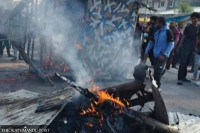National
State fails to allocate adequate budget to rebuild quake-ravaged public schools
The current delay means students will have to wait a few more years to shift from makeshift structures.Binod Ghimire
Students from hundreds of public schools studying in makeshift structures after the twin earthquakes four years ago will have to wait at least a few more years to sit inside permanent buildings because the government won’t allocate the necessary budget for the reconstruction of earthquake-ravaged school buildings.
The Central Level Project Implementation Unit (Education), an entity under the National Reconstruction Authority, had sought Rs 11 billion to reconstruct 1,806 public school buildings in the current fiscal year. The Ministry of Finance allocated Rs 9.23, and even that includes Rs 8 billion in loans pledged by the Indian government through Exim Bank.
Officials at the unit say there are so many conditions imposed to spend the Rs 8 billion, making it impossible to use it for the construction of school buildings. Ensuring 70 percent of the materials used in the construction come from India and granting the contracts only to the Indian construction companies are some of the preconditions required for using the loan amount.
Dilip Shekhar Shrestha, deputy chief at the unit, said as the reconstruction of the school buildings is done by the communities, awarding contracts to Indian companies is impossible. Shrestha said it was also not possible to ensure that a majority of the construction materials come from India.
“We are simply not in a position to use the loaned amount, which means we can only spend Rs 1.23 billion and that is hardly 12 percent of what we require,” he told the Post.
Officials at the unit say the government’s fund for the current fiscal year is hardly enough to finish 200 school buildings. There are still 2,700 public schools damaged by the devastating earthquakes that are waiting for reconstruction. “If we are to calculate the cost to reconstruct all the schools, we are short of Rs 27 billion,” Shrestha said.
Though the government, while starting the reconstruction project in 2016, had announced that it will complete the rebuilding of all damaged schools by 2020, the sluggish progress shows there is no way the rebuilding work will be completed in time.
Parents of local students say it is an example of the sheer incompetence of the government that hundreds of schools await reconstruction though it has already been more than four years since the disaster.
“The government hasn’t realised how difficult it is for the students to study inside makeshift structures during monsoon and winter,” said Suprabhat Bhandari, president of the Nepal Federation of Guardians. “The reconstruction of the school buildings must be a priority project for the government.”
Government records show over 33,000 classrooms from 7,923 public schools in 32 districts were destroyed in the earthquakes. After 370 such schools were merged due to the lack of enough students, 7,553 school buildings had to be rebuilt.
The Post-Disaster Recovery Framework prepared by the National Reconstruction Authority in 2016 had estimated that Rs 180 billion would be required for the construction of the quake-destroyed academic institutions and that Rs 167 billion would be needed to rebuild schools and classrooms.
The budget was later revised to Rs 119 billion, out of which Rs 50 billion has been pledged by donors in form of loans and grants.




 18.12°C Kathmandu
18.12°C Kathmandu













%20(1).jpg&w=300&height=200)

